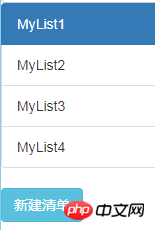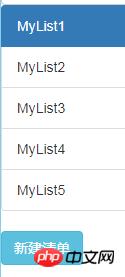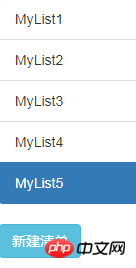
This time I will show you how to confirm that ng-repeat rendering is completed, and what are the precautions for confirming that ng-repeat rendering is completed. The following is a practical case, let's take a look.
A certain project, there is a list element in my web page, the style is as follows:
 ##In fact it It is formed through ng-
##In fact it It is formed through ng-
of Angular. The code in html is: <div class="code" style="position:relative; padding:0px; margin:0px;"><pre class="brush:php;toolbar:false"><li ng-repeat="for list in lists()" id="{{ list.id }}">{{ list.name }}</li></pre><div class="contentsignin">Copy after login</div></div>New list at the bottom of the picture
, after clicking it, a new list object will be push into the lists array. At this time, the page will be automatically rendered, and a # will be added accordingly. ##<li>, as follows:
Note that  MyList1
MyList1
active state ( class="active"), my requirement is to set the new list to active## after adding list #, that is, after adding it, it will become the following style: At first I tried to go to ## in the function corresponding to
#lists After
After
a new list object in the array, use document.getElementById to get the new <li> object, and then add a class="active"<a href="http://www.php.cn/code/658.html" target="_blank"> to it. It turns out that the obtained </a>DOM object is null. After Search found that the reason is: after pushing the push object to the listsarray, the array changes, and all <li> will be re-rendered. After push is completed, immediately look for the newly added DOM object. DOM has not been rendered yet, so it cannot be obtained. The solution is: use the AngularJS instruction to monitor whether the ng-repeat is completed, and after the rendering is completed, get the newly added < li><a href="http://www.php.cn/angularjs/angularjs-examples.html" target="_blank">Object, there is a lot of related content on this Internet, the code is as follows: </a><div class="code" style="position:relative; padding:0px; margin:0px;"><pre class="brush:php;toolbar:false">myapp.directive('repeatFinish', function ($timeout) {
return {
restrict: "C",
link: function (scope, element, attr) {
if(scope.$last === true){
$timeout(function () {
scope.change_list(element[0]);
}, 10);
}
}
}
});</pre><div class="contentsignin">Copy after login</div></div>The above code creates a command named repeatFinish, restrict: "C " means that the instruction is placed in
of DOM (camel case, i.e. class="repeat-finish"), scope.$ last === true means that the last object has been rendered, and the change_list function is executed at this time (defined in the controller, the function is to change the current active object cancels active, and then sets the incoming DOM object to active), element[0] can directly get the current The rendered DOM element. Note that I used $timeout, and change_list was executed after 10ms. I found that using change_list directly would still not find the DOM. , the reason is unknown, I look forward to the answer from the master. I believe you have mastered the method after reading the case in this article. For more exciting information, please pay attention to other related articles on the php Chinese website! Recommended reading:
Do not use vue Summary of code specification detection methods
The above is the detailed content of How to confirm that ng-repeat rendering is completed. For more information, please follow other related articles on the PHP Chinese website!




